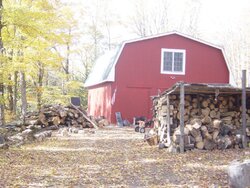It's been well documented that dry wood makes a world of difference in any wood burner. And the btu ratings of different woods is also easily found. I have discovered(not to my surprise though) that hardwoods make a big difference versus soft woods in sustaining hot coals to make "re-ignition" so much easier. We have enjoyed a much warmer than normal heating season to this point so I have been burning a lot of pine since we have not had much of a need for daytime heat. I've been trying to save my dry oak for the winter. The pine burns so fast and leaves mostly just ash and even using the timer on my WG it has been difficult to maintain a hot bed for easy morning lighting/feeding.
I did not get a new supply of pine into the basement this week before the 3+ inches of rain fell so I was forced to use my oak which was kept dry the last 2 days....what a difference The first morning I opened the door I had plenty of hot coals glowing at me after a night of fairly warm temps and I did not use the timer to keep the coals going through the night.
The first morning I opened the door I had plenty of hot coals glowing at me after a night of fairly warm temps and I did not use the timer to keep the coals going through the night.
So this makes me wonder how do the folks that have to burn soft wood manage?? It was actually getting to be a bit of a pain feeding the boiler so frequently as the pine would burn down so quickly. Granted, I was burning fairly small fires due to small demand but it seems soft wood burns so fast people must have to load their boilers 4 to 5+ times/day?? I'm hoping with good dry hardwood I will be loading 3 times max per day??
I did not get a new supply of pine into the basement this week before the 3+ inches of rain fell so I was forced to use my oak which was kept dry the last 2 days....what a difference
 The first morning I opened the door I had plenty of hot coals glowing at me after a night of fairly warm temps and I did not use the timer to keep the coals going through the night.
The first morning I opened the door I had plenty of hot coals glowing at me after a night of fairly warm temps and I did not use the timer to keep the coals going through the night.So this makes me wonder how do the folks that have to burn soft wood manage?? It was actually getting to be a bit of a pain feeding the boiler so frequently as the pine would burn down so quickly. Granted, I was burning fairly small fires due to small demand but it seems soft wood burns so fast people must have to load their boilers 4 to 5+ times/day?? I'm hoping with good dry hardwood I will be loading 3 times max per day??


